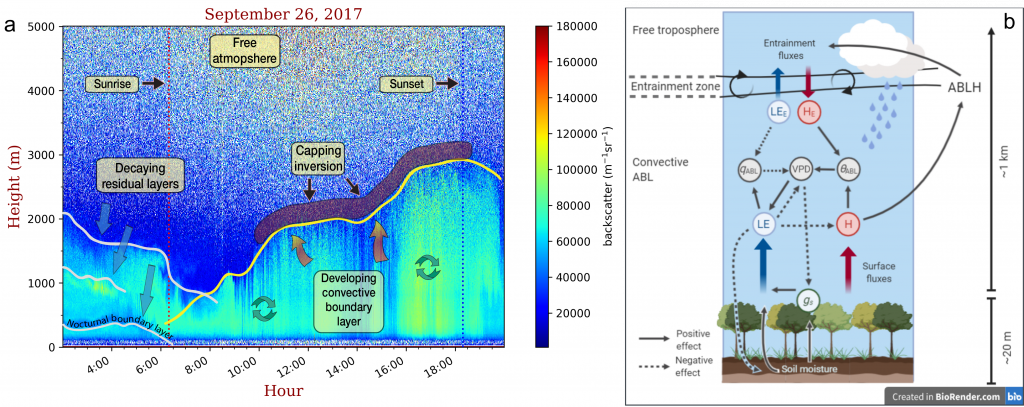The AmeriFlux network – with its ever growing availability of surface flux measurements – has contributed to important advancements in our understanding of biosphere-atmosphere interactions. Most studies have investigated ecosystem responses to meteorological or environmental drivers and have only rarely included feedbacks between land surface processes, atmospheric boundary layer dynamics, and the free troposphere. Currently, continuous atmospheric boundary layer observations at AmeriFlux sites are still scarce, limiting our ability to investigate the close coupling between land surface and atmospheric processes. However, understanding land-atmosphere coupling is key to better predicting global and regional climate trends.
At last year’s AmeriFlux Annual Meeting in Boulder, Colorado a group of AmeriFlux scientists discussed during a breakout session how the addition of detailed atmospheric boundary layer observations at AmeriFlux sites could open new research opportunities and add value to ongoing flux measurement efforts. It emerged from this breakout session that there is a strong desire by the flux community to expand boundary layer observations across the network. Additionally, making existing observations available to the AmeriFlux network and coordinating new observation efforts would help the community to advance our understanding of land-atmosphere interactions across biomes and climates.

As a result of this breakout session, a working group of 26 PIs and early career scientists was organized to write a white paper on the benefits of adding atmospheric boundary layer observations to AmeriFlux tower sites. Now, the white paper “Understanding biosphere-atmosphere interactions through tower-based flux and continuous atmospheric boundary layer measurements” is published on the AmeriFlux website. The paper aims to highlight the new research questions that can be tackled with co-located observations of surface fluxes and atmospheric boundary layer properties and to initiate a discussion in the AmeriFlux community on best practices when it comes to conducting and sharing boundary layer observations.
We highlight four key opportunities to integrate tower-based flux measurements with continuous, long-term atmospheric boundary layer measurements:
(1) to interpret surface flux and atmospheric boundary layer exchange dynamics at flux tower sites,
(2) to support regional-scale modelling and upscaling of surface fluxes to continental scales,
(3) to validate land-atmosphere coupling in Earth system models, and
(4) to support flux footprint modelling, the interpretation of surface fluxes in heterogeneous terrain, and quality control of eddy covariance flux measurements.
Thus, adding a suite of atmospheric boundary layer measurements to eddy covariance flux tower sites would allow the Earth science community to address new emerging research questions, to better interpret ongoing flux tower measurements, and would present novel opportunities for collaboration between AmeriFlux scientists and atmospheric and remote sensing scientists. We therefore recommend
- addition of a set of instrumentation for continuous atmospheric boundary layer observations to a subset of AmeriFlux sites spanning a range of ecosystem types and climate zones,
- solicitation by funding agencies (e.g., Department of Energy, NOAA, NASA) for research on land-atmosphere processes where the benefits of fully integrated atmospheric boundary layer observations can add value to key scientific questions, and
- acquisition of loaner instrumentation by the AmeriFlux Management Project for atmospheric boundary layer observations for use in experiments and short-term duration campaigns.
We hope that our ideas and visions will resonate with the AmeriFlux community and are looking forward to discussing how atmospheric boundary layer observations can make the AmeriFlux network an even more impactful community project.

a Example of the diurnal development of a backscatter profile from a Lufft CHM15k ceilometer at the USDA-ARS Walnut Gulch Experimental Watershed site in Tombstone, AZ. b Daytime feedbacks between surface energy fluxes, entrainment fluxes, land surface and vegetation conditions and state of the atmospheric boundary layer. The atmospheric boundary layer height (ABLH) separates the convective ABL from the free troposphere.

No Comments
Be the first to start a conversation